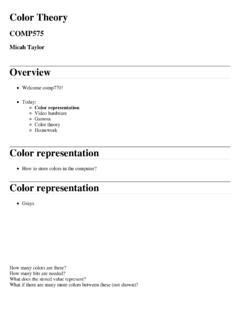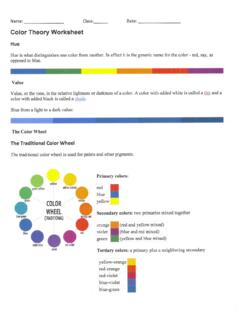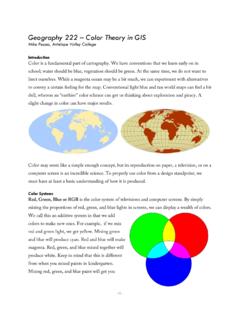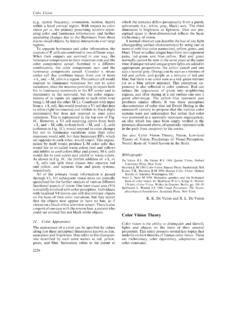Transcription of COLOR THEORY - cdn.davemorrowphotography.com
1 COLOR THEORY PHOTOGRAPHY GUIDE FROM DAVE MORROW PHOTOGRAPHY Page 2 Table of Contents This PDF is Volume 1 of my Photography Fundamentals Tutorial Series . Visit the linked page for the latest & most up to date photo guides. COLOR THEORY Photography Video4 Understanding COLOR & Light4 Creating COLOR - Light Waves & Frequency5 Understanding Light Frequency6 Photons - The Building Blocks of Light7 Pixels - Buckets for Collecting Light8 The Language of COLOR & Light9 RGB COLOR Wheel9 Luminance - The Absolute Measurement of Light10 Brightness - Our Perception of Luminance10 Lightness ( Luminosity ) - Our Perception of Brightness11 Understanding Luminosity - Brightness vs. Lightness12 What is Hue?14 What is Tint, Shade & Tone?14 What is Saturation in Photography?
2 17 Photo Editing with The COLOR Wheel18 HSL vs. HSV in Photoshop19 The HSV/HSB Coordinate System19 The HSL Coordinate System21 Key Points to Remember - HSL vs. HSB23 Understanding COLOR Harmony23 COLOR Harmony24 Types of COLOR Harmonies26 START HERE | LEARN PHOTOGRAPHY | VIEW PHOTOS | WORKSHOPS & TOURS Page 3 Key Color27 Direct / Complementary COLOR Harmony29 Analogous COLOR Harmony31 Triadic COLOR Harmony32 Split-Complementary COLOR Harmony34 Square COLOR Harmonies36 Landscape Photography Tips for COLOR Theory38 Blue & Turquoise39 Red, Orange & Yellow40 Green42 Green in Direct Sunlight42 Green Without Direct Light43 Green in Shadows44 Magenta45 Final Thoughts on COLOR Theory46 START HERE | LEARN PHOTOGRAPHY | VIEW PHOTOS | WORKSHOPS & TOURS Page 4 COLOR THEORY Photography Video The following video gives a basic overview of all the techniques and skills covered on the following page.
3 I also included a bonus COLOR THEORY photo editing example at the end with the following image. Click Here & Watch the Video Understanding COLOR & Light Light is the single basic ingredient required to create photographs. Without light, pictures don t exist. Digital photography is the process of transferring light energy, carried by photons, into digital information, which can be processed and displayed by computers and cameras in the form of digital images. Light also contains the ability to produce COLOR . COLOR is produced by specific energies or frequencies of light, known as visible light. START HERE | LEARN PHOTOGRAPHY | VIEW PHOTOS | WORKSHOPS & TOURS Page 5 Understanding COLOR THEORY and creating beautiful images requires a basic knowledge of COLOR & light.
4 This basic understanding is essential for mastering all other aspects of photography, including shooting & photo editing. Creating COLOR - Light Waves & Frequency Light waves carry energy, determined by frequency, carried by small packets known as photons. This energy provides the basis for human vision, solar power and digital photography. The human eye can see light that exhibits a certain range of energy. Energy contained in light photons interacts with the retina ( rods & cones ), releasing energy as electrons, creating electrical impulses, communicating with our brain to produce vision. Specific colors correspond to specific frequencies of light as shown in the graphic below. Graphic Attribution - Philip Ronan START HERE | LEARN PHOTOGRAPHY | VIEW PHOTOS | WORKSHOPS & TOURS Page 6 When light waves & photons interact with silicon image sensors free electrons are released from the collision.
5 The number of electrons released depends on the photon energy. The photon energy depends on the light frequency. Pixels are small buckets for collecting & counting electrons. They are the basic building block of image sensors found in digital cameras. Understanding Light Frequency Compare light & light waves to ocean water hitting the beach as waves throughout the day. Although the ocean is a single object, each of its waves carries different amounts of energy, acting as a separate entity. Storm waves coming in very quickly, hitting the beach one after another, every second, contain a large amount of energy, often destroying buildings or boats. Calm weather waves may only hit the beach every minute. The energy contained in calm weather waves is much less, allowing visitors to lay on the beach in the sun.
6 The energy carried by these waves can be defined by the frequency or number of waves coming in one after another. The horizontal distance from the top of one wave to the top of the following wave is defined as 1 wavelength. Waves coming in during a storm, very quickly, have a high frequency. High-frequency waves have small wavelengths with less distance from one wave top to the next. START HERE | LEARN PHOTOGRAPHY | VIEW PHOTOS | WORKSHOPS & TOURS Page 7 During calm weather waves have a low frequency. Low-frequency waves have large wavelengths as the distance from the top of one wave to the next is much larger. The characteristics of wavelength and frequency determine the energy carried by water and by light waves.
7 Photons - The Building Blocks of Light Photons are the basic building blocks ( particles ) of light waves, which carry energy, determined by wave frequency. The number of photons is proportional to the amount of energy & light. More Light = More Photons = More Energy Less Light = Less Photons = Less Energy Photons make up light waves yet have the ability to interact with their surroundings as singular particles. Photons are waves and particles at the same time, thus photons maintain a wave nature . This wave-particle nature or Wave-Particle Duality as taught in particle physics and quantum mechanics. Light does not contain COLOR and neither do photons. Light & photons carry energy determined by frequency. When this energy interacts with another object, evolved or designed to see visible light, such as the human eye or an image sensor, COLOR is perceived.
8 Different colors are the resultant of different light energy levels, determined by the the light wave s frequency, using the following simple equation: START HERE | LEARN PHOTOGRAPHY | VIEW PHOTOS | WORKSHOPS & TOURS Page 8 E = h*f E is the photon energy, h, is Planck s Constant & f is the lightwave s frequency. Increased Frequency = Decreased Wavelength = Higher Photon Energy Decreased Frequency = Increased Wavelength = Lower Photon Energy Pixels - Buckets for Collecting Light As light / photons collide with the image sensor free electrons are released from the sensor's surface. Imagine a missile ( photons ) hitting a brick wall ( sensor ), pieces of brick ( electrons ) will fly everywhere. Each free electron carries a small electronic charge.
9 Pixels, the smallest unit of the image sensor, are buckets for storing and counting electrons and their corresponding electronic charge. This charge, collected by each pixel, produces a digital signal which communications the pixel COLOR into digital space, using binary code ( zeros & ones ). This massive amount of information is all carried by light, at the speed of 299,792,458 meters per second or 983,546,666 feet per second. This entire section can be summed up by the following two equations: More Light = More Photons = More Electrons = Larger Signal = More Photo Information Less Light = Less Photons = Less Electrons = Smaller Signal = Less Photo Information START HERE | LEARN PHOTOGRAPHY | VIEW PHOTOS | WORKSHOPS & TOURS Page 9 The Language of COLOR & Light Prior to learning COLOR THEORY , which contains the best practices for mixing, editing and displaying COLOR in photographs, a basic understanding of the technical language is required.
10 This language is also used by camera software, and image editing programs such as Lightroom, Camera RAW, Capture One, and Photoshop. RGB COLOR Wheel The RGB COLOR Model, most often used in photography, is a language of COLOR . A COLOR model is a system used to define & communicate COLOR . RGB simply defines the primary colors for this model which are Red, Green, and Blue. COLOR gamut is the entire range of possible colors which can be produced by mixing the three primary colors. Combining primary colors, which lie adjacent to each other on the COLOR wheel, produces secondary colors. START HERE | LEARN PHOTOGRAPHY | VIEW PHOTOS | WORKSHOPS & TOURS Page 10 Red and blue produce magenta, blue and green produce cyan, green and red produce yellow.










